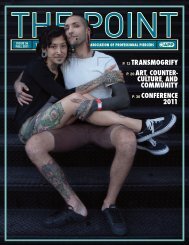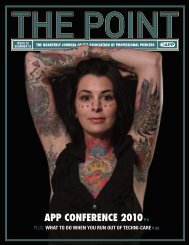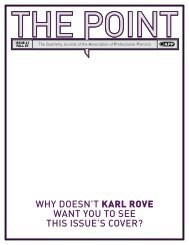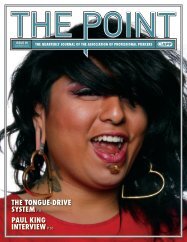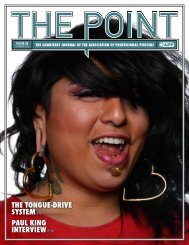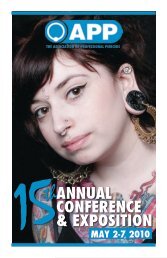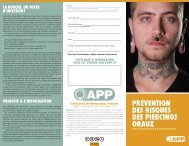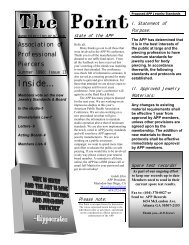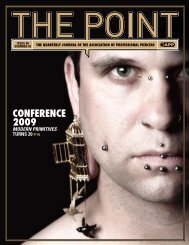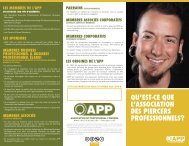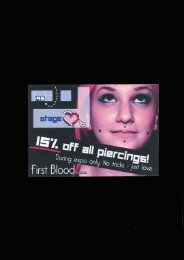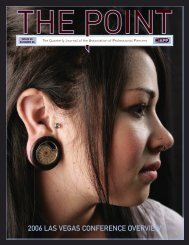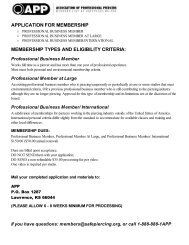Download It - Association of Professional Piercers
Download It - Association of Professional Piercers
Download It - Association of Professional Piercers
Create successful ePaper yourself
Turn your PDF publications into a flip-book with our unique Google optimized e-Paper software.
ISSUE 53<br />
FALL 10<br />
Glass Jewelry in<br />
Vietnam and China p.14<br />
PLUS: PIErcINg SEmINarS IN cHIlE p.11<br />
ISSUE 53 • THE POINT 1
from the editor<br />
elayne anGel<br />
aPP medical liaison<br />
yucatan, mexico<br />
When the subject <strong>of</strong> the upcoming APP elections was raised, I was asked if I would consider<br />
running to serve again when my current three-year term is up next May. A big part <strong>of</strong> me<br />
thought, “No, nine years <strong>of</strong> volunteering is probably quite enough for anyone. Maybe it is<br />
time to take a break.” I’ll admit that I thought, “Well, it is a lot <strong>of</strong> responsibility and effort,<br />
and a big time commitment, too...” but I love the organization and cherish my participation<br />
in it, and find that serving on the Board is incredibly rewarding. What to do?<br />
Shortly after my internal conversation, I opened my <strong>of</strong>fice cabinet to get out some<br />
staples, and I rediscovered my archive <strong>of</strong> all the APP brochures I helped to write. As I<br />
looked over the various formatting styles, color schemes, and layouts, I thought about<br />
how far the organization has come and the role I’ve had in bringing us where we are<br />
today—a respected and trusted source for piercing information.<br />
There’s quite a dramatic difference between the first versions, printed on white paper<br />
in black ink, to the slick, full-color folios we have now. Each incarnation represents<br />
an advancement, and another era <strong>of</strong> my participation. Obviously and importantly,<br />
they’re a group effort, but I can still take pride in the accomplishment (as can—and<br />
should—each <strong>of</strong> the individuals who were involved). I’d like to again thank my coeditor,<br />
James Weber, APP President and chair <strong>of</strong> the media committee, for all <strong>of</strong> his<br />
amazing work in updating our image online and in print. Under his direction, the<br />
brochures, Web site, and quarterly journal you’re now reading all have a cohesive and<br />
pr<strong>of</strong>essional presentation—and they look better than ever.<br />
Now our association has taken another step forward thanks to Sandrine Skellie (wife<br />
<strong>of</strong> Brian Skellie, one <strong>of</strong> our two new members <strong>of</strong> the APP Board). I’m proud to announce<br />
that the APP has new French translations <strong>of</strong> ALL <strong>of</strong> our informational brochures. She<br />
did a lot <strong>of</strong> work on them and deserves our gratitude. Thank you Sandrine, for opening<br />
up our information to a whole new population <strong>of</strong> people. The French brochures are<br />
now available on the APP site (www.safepiercing.org) in the form <strong>of</strong> a free download<br />
for French Canadian, European, and French-speaking piercees and piercers worldwide.<br />
While we’re on the subject, we also owe Danny Yerna our thanks for the hard work he<br />
put into translating all <strong>of</strong> the APP brochures into Spanish (as well as the Web site and<br />
procedure manual). The Spanish brochures are also available from the APP Web site for<br />
free download. Even our newest brochures, Jewelry for Initial Piercings and Jewelry for<br />
Healed Piercings, have both been translated into Spanish and are at the printer now. (They<br />
appeared in English in the centerfold <strong>of</strong> Point #51.)<br />
While I’m at it, thanks to one <strong>of</strong> our new Board Members, Brian Skellie, for uploading<br />
these brochures and continuing to update our Web site.<br />
In other related news, there are two new brochures soon to be available in print: facial<br />
and body aftercare specifically designed for minors (without information on nipples or<br />
genital piercings and with simplified language) and an oral aftercare for minors, too.<br />
When the APP does outreach at medical, dental, and other health-related conferences<br />
and tattoo conventions, these brochures are our voice. They carry our message out<br />
from the conference halls and into different communities. I am confident that they<br />
are truly helping people to get safer piercings, and that’s a tremendous and worthwhile<br />
accomplishment.<br />
I was smiling peacefully as I set down the stack <strong>of</strong> brochures from eras gone by. My<br />
internal struggle came to an end, and I felt happy about my decision to run in the<br />
upcoming election. So if the organization would like to have me back, I’ll be at your<br />
service once again—perhaps to write more new brochures.<br />
While we’re waiting for all the ballots to be counted, please enjoy issue #53 <strong>of</strong> The Point:<br />
The Journal <strong>of</strong> the <strong>Association</strong> <strong>of</strong> Pr<strong>of</strong>essional <strong>Piercers</strong>. P<br />
THE POINT<br />
The QuarTerly Journal <strong>of</strong> The associaTion <strong>of</strong> Pr<strong>of</strong>essional <strong>Piercers</strong><br />
Board <strong>of</strong> direCtors<br />
James Weber: President<br />
Didier Suarez: Vice President<br />
Elayne angel: Medical Liaison<br />
Eduardo chavarria: Membership Liaison<br />
Brian Skellie: International Liaison<br />
Dana Dinius: Outreach Coordinator<br />
<strong>of</strong>fiCers<br />
James Weber: President<br />
Bethra Szumski: Secretary<br />
Paul King: Treasuer<br />
administrator<br />
Caitlin McDiarmid<br />
The <strong>Association</strong> <strong>of</strong> Pr<strong>of</strong>essional <strong>Piercers</strong> is a Californiabased,<br />
international non-pr<strong>of</strong>it organization dedicated to the<br />
dissemination <strong>of</strong> vital health and safety information about body<br />
piercing to piercers, health care pr<strong>of</strong>essionals, legislators,<br />
and the general public.<br />
Material submitted for publication is subject to editing.<br />
Submissions must be in a digital format, and should be sent<br />
via email to medical@safepiercing.org.<br />
The Point is not responsible for claims made by our<br />
advertisers. However, we reserve the right to reject advertising<br />
that is unsuitable for our publication.<br />
Point staff<br />
Editors: James Weber and Elayne Angel<br />
assisting Editors: Kimberly Zapata,<br />
Jennifer Heimburg, and Angela Smith<br />
art Direction: Jon Loudon<br />
advertising: info@safepiercing.org<br />
Front cover: Lejandra Carbajal, photographed by Gregory<br />
Allen (plasticimage.com). Photo courtesy Jason Pfohl and<br />
Gorilla Glass. Back cover: Fan dance at the Oslo SusCon.<br />
Photo by Allen Falkner, suspension.org.<br />
Unless stated otherwise, content <strong>of</strong> this<br />
issue <strong>of</strong> The Point is licensed under the<br />
Creative Commons Attribution-Noncommercial-No Derivative Works<br />
License. To view a copy <strong>of</strong> this license, visit http://creativecommons.org/<br />
licenses/by-nc-nd/3.0/<br />
aSSOcIaTION OF PrOFESSIONal PIErcErS<br />
1.888.888.1APP • sAfePiercing.org • info@sAfePiercing.org<br />
Donations to The Point are always appreciated.<br />
inside this issUe<br />
4<br />
6<br />
11<br />
12<br />
14<br />
20<br />
24<br />
26<br />
28<br />
President’s corner<br />
seminArios de chile<br />
chile seminArs<br />
OSLO SUSCON<br />
glAss Piercing Jewelry<br />
IN SOUTHEAST ASIA AND CHINA<br />
inventory control<br />
tAttooing is ruled “free sPeech”<br />
by u.s. court <strong>of</strong> APPeAls<br />
the british JournAl <strong>of</strong> medicAl PrActitioners<br />
Publishes study on men with genitAl Piercings<br />
re/seArch interviews
2<br />
adVertise with<br />
THE POINT<br />
The QuarTerly Journal <strong>of</strong> The associaTion <strong>of</strong> Pr<strong>of</strong>essional <strong>Piercers</strong><br />
Free for download in full color at safepiercing.org,<br />
and printed with a full-color cover<br />
and black-and-white content.<br />
See The<br />
BEAUTY<br />
<strong>of</strong> our<br />
INSURANCE<br />
PROGRAM<br />
<br />
Coverage Available For:<br />
■ Body Piercing<br />
■ Tattoo Services<br />
■ Permanent Makeup<br />
■ Medi-Spas<br />
■ Pr<strong>of</strong>essional Liability<br />
■ General Liability<br />
■ Property, if needed.<br />
Available in all 50 states.<br />
For more information, have your<br />
insurance agent call Lyla Byers at:<br />
2010 ad rates<br />
(SINglE INSErTION/FOUr ISSUE cOmmITTmENT)<br />
INSIDE cOvErS: $600/$550<br />
FUll PagE: $500/$450<br />
HalF PagE: $275/$250<br />
QUarTEr PagE: $175/$150<br />
informaTion on adverTising can be found aT hTTP://www.safePiercing.org/PublicaTions/The-PoinT/adverTise/<br />
or email info@safePiercing.org<br />
<br />
<br />
■ <br />
<br />
THE POINT • ISSUE 53
When we consider our audience —“we” being those <strong>of</strong> us involved<br />
in outreach for the APP—we generally think <strong>of</strong> them as belonging to<br />
one <strong>of</strong> four groups: piercers, healthcare pr<strong>of</strong>essionals, legislators, or the<br />
general public. In previous years, and on previous Boards, much <strong>of</strong> the<br />
APP’s energy and resources outside <strong>of</strong> our annual Conference (at least<br />
domestically) were devoted to medical pr<strong>of</strong>essionals and legislators. Ten<br />
years ago, as piercing continued to permeate mainstream culture, most<br />
healthcare practitioners, faced with patients who had piercing-related<br />
questions and issues, found themselves unsure <strong>of</strong> where to send them<br />
for information. The APP began to engage in aggressive outreach at<br />
medical conferences; we started staffing a booth at the American Public<br />
Health <strong>Association</strong> (APHA) and American College Health <strong>Association</strong><br />
(ACHA) annual conferences. We spoke to<br />
attendees, handed out our printed materials,<br />
and made contacts in these communities that<br />
are maintained to this day. Several years ago,<br />
we added the American Dental Hygienists’<br />
<strong>Association</strong> (ADHA) conference to our roster<br />
to help educate dental hygienists and discuss<br />
the risks associated with oral piercings in an<br />
informed setting—and to counter some <strong>of</strong><br />
the prejudicial and inaccurate information<br />
that was being disseminated at the time by the<br />
American Dental <strong>Association</strong>.<br />
As a whole, healthcare organizations—with<br />
our encouragement—slowly began to agree that this was a public<br />
health issue. This, in turn, led to an interest in body piercing by those<br />
responsible for producing legislation to safeguard public health. Often,<br />
the legislative bodies overseeing the drafting <strong>of</strong> these new body art<br />
regulations are not adequately informed about our industry. In response<br />
to this need, we have continued to act as a liaison between those from<br />
our industry and those who seek to regulate what we do.<br />
After laws are in place, the health boards charged with inspecting<br />
studios and enforcing those regulations are <strong>of</strong>ten lacking education as<br />
well. To fill this need, in addition to distributing information through<br />
the APP <strong>of</strong>fice, we waive all entrance fees to our annual Conference<br />
for any health inspectors attending. Three years ago, to be more<br />
proactive in our outreach to this group, we began staffing a booth at<br />
the National Environmental Health <strong>Association</strong> (NEHA) conference,<br />
talking to attendees involved in environmental health services—such<br />
as inspection <strong>of</strong> body art establishments. (To read about my experience<br />
at the first two NEHA conferences, check out issues #44 and #49 <strong>of</strong><br />
The Point.)<br />
The focus and direction <strong>of</strong> previous outreach done on behalf <strong>of</strong> the<br />
APP has been incredibly effective in reaching healthcare pr<strong>of</strong>essionals<br />
and legislators, and anyone active in our industry over the last ten years<br />
would probably agree that there has been a drastic increase in piercingrelated<br />
knowledge by those involved with public health. I would like<br />
4<br />
President’s Corner<br />
James weBer<br />
aPP President<br />
Infinite Body Piercing, Inc.<br />
Philadelphia, PA<br />
to say that the APP can take credit for this increase in knowledge, but<br />
several things came together to make this happen: piercers became<br />
more proactive, <strong>of</strong>ten in response to pending legislation (and frequently<br />
with the help <strong>of</strong> the APP and its members); body piercing became<br />
such a widespread practice that healthcare pr<strong>of</strong>essionals, regardless <strong>of</strong><br />
their opinion on the subject, were forced to educate themselves about<br />
piercing; and regulations started to be put into place for body art, and<br />
these laws <strong>of</strong>ten had a domino effect in that legislation in one area<br />
signaled a need for the same in other towns, cities, and states. Add to<br />
this the Internet, and information on body piercing is readily available<br />
to groups that it wasn’t before.<br />
The seeds <strong>of</strong> this work have now matured, and the full effect <strong>of</strong> this<br />
As a whole, healthcare organizations—with our<br />
encouragement—slowly began to agree this was a<br />
public health issue. This, in turn, led to an interest<br />
in body piercing by those responsible for producing<br />
legislation to safeguard the public health.<br />
outreach is now apparent. The last few times I’ve worked the APP<br />
booth at the medical conferences we regularly attend, the feedback<br />
from attendees has been similar: conference-goers are familiar with<br />
the APP and what we do and many are returning to our booth to see<br />
what updated material we have, or to pick up information for a coworker.<br />
Because <strong>of</strong> our long-term efforts, we have ongoing pr<strong>of</strong>essional<br />
standing with both <strong>of</strong> these groups.<br />
In the last several years, we have increased our efforts toward<br />
education <strong>of</strong> the general public as well. The APP Website was completely<br />
redesigned eighteen months ago and continues to be improved by both<br />
Elayne Angel (our Medical Liaison, Point co-editor, and APP brochure<br />
writer), and Brian Skellie (our new International Liaison and Web<br />
guru). And while we don’t yet have the budget for full-page ads in<br />
Cosmopolitan or Rolling Stone (as was discussed at one APP Member’s<br />
meeting years ago), we’ve been successful in getting into other national<br />
publications: everything from a mention in Curve (thanks again to<br />
Elayne) to a multiple-page spread in Penthouse.<br />
Our international outreach to piercers has never been stronger. After<br />
putting on two APP Conferences in Amsterdam (in 2002 and 2003),<br />
representatives from our organization are still traveling to Europe for<br />
events that have been organized in the wake <strong>of</strong> our previous efforts:<br />
BMXnet is now a yearly event (see The Point issues #43, 45, and 50),<br />
and events in both <strong>It</strong>aly (The Point issues #38, 47, and 51) and Norway<br />
THE POINT • ISSUE 53
(The Point #45 and page 12 <strong>of</strong> this issue) can all be said to owe a debt to<br />
our early outreach. Our annual APP Mexico Seminars (reported on in<br />
issues #35, 42 ,45, and 50) are still drawing about 50% new attendees<br />
every year, and the effects <strong>of</strong> this work are starting to trickle down to<br />
South America as well (see page 6 in this issue).<br />
So what’s next? What’s the next big push to educate about safe<br />
piercing practices and the APP? <strong>It</strong> just may be tattoo conventions.<br />
As reported on in issue #47 <strong>of</strong> The Point, the APP was provided vendor<br />
space at the Philadelphia Tattoo Arts Convention in March <strong>of</strong> 2009.<br />
In addition to once again manning a booth at this year’s Philadelphia<br />
Convention, booth space was donated to us at the Hell City Tattoo<br />
Convention in Columbus, Ohio and, as I write this, preparation is<br />
under way to bring the APP booth to the Baltimore Tattoo Arts Festival<br />
the second week in September.<br />
Through these few events, we have been in contact with literally<br />
thousands <strong>of</strong> attendees—people who would be difficult to reach any<br />
other way. We talked to scores <strong>of</strong> piercers—but even more than that,<br />
we spoke to dozens <strong>of</strong> apprentices and people who were just thinking<br />
about getting started in the industry. There were people with a passion<br />
for piercing and body art who are just starting on their journey <strong>of</strong> selfdiscovery,<br />
people whose journey could easily lead them into the ranks<br />
<strong>of</strong> our membership in a few years. And, <strong>of</strong> course, we talked with the<br />
public.<br />
There is a marked difference in the education we provide at these<br />
conventions, as reflected in the type <strong>of</strong> materials distributed here in<br />
comparison to other events. At medical conferences, we hand out<br />
brochures by the boxful to people from the outside looking in; people<br />
with little knowledge <strong>of</strong> our industry who—because <strong>of</strong> position or<br />
occupation—need information about what the APP is and does. At<br />
tattoo conventions, we primarily hand out copies <strong>of</strong> The Point.<br />
Most tattoo convention attendees are people in and around our<br />
industry; they are piercers, apprentices, tattoo artists, tattoo shop<br />
owners, or simply body art collectors and fans—the cross-section <strong>of</strong> the<br />
public that has been so elusive. These attendees are inside our industry<br />
looking out; they want information about what it means to do what<br />
we do and what concerns we (and they) have as an industry—and what<br />
the APP is doing to address them. The Point is perfectly poised to fill<br />
this need.<br />
With the near-ubiquitous use <strong>of</strong> the Internet, it’s easier than it used<br />
to be to find the APP; with a fully functioning Website and an <strong>of</strong>fice<br />
and administrator to answer questions, healthcare pr<strong>of</strong>essionals and<br />
legislators usually find us if they need us. What is needed now is to give<br />
those on the inside not only information but context for information.<br />
This is one reason our tattoo convention outreach is so crucial. Years<br />
<strong>of</strong> attendance at medical conferences have helped solidify our role<br />
as educators to medical pr<strong>of</strong>essionals, legislators, and inspectors. I’m<br />
excited about this new outreach, and I’m optimistic about where this<br />
will bring us in our conversation with these groups in the future.<br />
While I’ll only be occupying my seat on the Board <strong>of</strong> Directors until<br />
next May, the seeds <strong>of</strong> change have once again been planted, and I look<br />
forward to seeing what future APP members decide to do with the<br />
results that will undoubtedly be sprouting in the near future.<br />
[Special thanks are due to Troy Timpel and Durb Morrison their<br />
generosity and support <strong>of</strong> the APP, and for graciously continuing to<br />
donate booth space to our organization.] P<br />
hell City tattoo festiVal<br />
Kyle Petersen<br />
Infinite Body Piercing, Inc<br />
Philadelphia, PA<br />
Outreach. As an organization, we tend to take a pr<strong>of</strong>essional<br />
approach to staffing the APP booth at health conferences and<br />
when talking with legislators and health inspectors. <strong>It</strong> has served<br />
us and the industry well to legitimize what we do in the eyes <strong>of</strong><br />
other pr<strong>of</strong>essionals. But there has always been a shortcoming<br />
in both piercer-to-piercer outreach and outreach to the general<br />
public—until recently.<br />
<strong>It</strong> all started with a phone call to a friend <strong>of</strong> mine. His name<br />
is Durb Morrison–fantastic gentleman, brilliant tattoo artist, and<br />
organizer <strong>of</strong> the finest tattoo convention in all the land: Hell City<br />
Tattoo Festival. I asked him if he was willing to donate some space<br />
to the APP for us to set up and talk to people about safe piercing<br />
practices—and to distribute the information that we’re famous for.<br />
He was more than happy to help us out. What a guy.<br />
So me and the missus departed from Philadelphia bound for<br />
sunny Columbus, Ohio (my home town). After a long and perilous<br />
trip, we arrived and headed straight to the Hyatt, where the big<br />
show was located. We were given a really nice, heavily traveled<br />
area in the mezzanine, which meant you didn’t even have to pay<br />
for the convention to come visit our booth. Awesome.<br />
The weekend was a smash hit. As piercers, we were able to<br />
speak directly to clients (and potential clients), and the response to<br />
our presence there was overwhelmingly positive. Hopefully, this<br />
information will help to generate a million questions between piercers<br />
and clients when these individuals return to their regular piercers.<br />
I didn’t do this alone, and I had plenty <strong>of</strong> help from local piercers.<br />
Big thanks to Dave Kelso, Shawn Lower, Jared Anderson, and Al<br />
D. Scholarship Recipient Lauren Delahaye. Thanks a million to all<br />
who helped.<br />
Special thanks to Durb, who has donated space for his next<br />
show: Hell City in Phoenix, Arizona.<br />
ISSUE 53 • THE POINT 5
6<br />
seminarios de Chile<br />
osCar soto<br />
tintaletras.ning.com<br />
Nota y fotografias de Oscar Soto “feik.”<br />
Todo comenzó como una invitación abierta entre amigos y se<br />
transformó en una reunión con tanta organización y relevancia<br />
que hasta la misma APP se quiso hacer presente. Los tres días<br />
llenos de eventos sobre arte corporal, modificaciones y joyería,<br />
temas que nos apasionan, donde cualquier conversación, por<br />
superficial que pareciera, daba paso a mayores discusiones e<br />
intercambio de experiencias que buscaron soluciones y mejoras a<br />
las condiciones y conocimientos sobre el Body Piercing nacional.<br />
Estos seminarios se realizaron del 12 al 14 de Febrero del 2010<br />
en la 3ª región de Atacama y convoco a artistas pr<strong>of</strong>esionales de<br />
todo Chile. Todos los participantes tuvieron que presentar un<br />
currículum expresando su interés en asistir al evento el cual no<br />
tuvo mayor costo que el hospedaje y alimentos. La organización<br />
del evento estuvo a cargo del artista “Piercer” Copiapino<br />
Mauricio “Banana” Torres, de Estigma BodyArt , logrando un<br />
evento de excelente nivel, realizandose cada punto propuesto<br />
en el programa y todo a cambio de unas felicitaciones y unos<br />
buenos recuerdos.<br />
El primer día tuvieron lugar las charlas educativas en el<br />
Centro de Salud El Palomar, a cargo de pr<strong>of</strong>esionales de la salud,<br />
enfermeros y Médicos, quienes presentaron sobre Anatomía oral<br />
y Riesgos dentales (Dra. Karen Omon) y Anatomía de la piel,<br />
Histología y Riesgos en personas incompatibles con el piercing<br />
(Dr. Marcelo Bravo), Prevención de infecciones (Sra. Miriam<br />
González), y Primeros Auxilios, Desmayos, Lipotimias, Control<br />
de Hemorragias (Sr. Juan Pasten). Se realizó una Lóbulo plastia<br />
en vivo(reconstrucción de lóbulos), para que los asistentes,<br />
compararan sus procedimientos asépticos, con los de un<br />
THE POINT • ISSUE 53
pabellón de cirugías; el cual fue realizado a Felipe Silva (piercer<br />
iquiqueño), en la cual estuvieron presentes todos los invitados,<br />
intercambiando opiniones y técnicas, una instancia en la que<br />
los artistas demostraron sus conocimientos y pr<strong>of</strong>esionalismo,<br />
impresionando a los médicos invitados debido a la preocupación<br />
con que trataron los temas y por realizar todo bajo los más altos<br />
niveles de higiene. Cada médico destacó y aplaudió la iniciativa,<br />
y felicitaron a los asistentes por sus deseos de formalizar y luchar<br />
por un mejor futuro para el arte corporal Chileno.<br />
Finalizando las presentaciones, el grupo se trasladó a la<br />
localidad de Caldera, donde pudieron compartir y crear lazos<br />
de amistad fuera del tema que los reunía. Fiestas y cervezas<br />
en la noche, piscina y comida de la zona al otro día, crearon<br />
la antesala a la mesa redonda, que se llevó a cabo a orillas del<br />
mar en Bahía Inglesa, una instancia más íntima y privada en<br />
la que se conversó sobre Ética del perforador (tema propuesto<br />
por Gonzalo Sepúlveda), Cartílago (Javier Fingazz) y finalmente,<br />
pero no menos interesante, Acupuntura y Body Piercing (Eduardo<br />
Sierralta). Cada uno de los temas interesó a todos por igual,<br />
sirviendo para compartir experiencias en común, técnicas, visiones<br />
y puntos de vista, y para aprender sobre temas que son realmente<br />
new BroChUres<br />
in frenCh<br />
are available for download at safepiercing.org.<br />
TITlES INclUDE: Conseils Pour Une Meilleure Cicatrisation (Suggested<br />
Aftercare for Body Piercings), Bijoux Pour Piercing Cicatrises (Jewelry for Healed<br />
Piercings), Les Bijoux De Premiere Pose (Jewelry for Initial Piercings), Les Soins<br />
Specifiques aux Piercings Oraux (Suggested Aftercare for Oral Piercings), Prévention<br />
des Risques des Piercings Oraux (Oral Piercing Risks & Safety Measures),<br />
Bien Choisir Son Pierceur (Picking Your Piercer)<br />
[These brochures are currently available for download only.]<br />
To order, contact the APP <strong>of</strong>fice at 888.888.1aPP<br />
or email info@safepiercing.org<br />
You do not need to be an APP member to purchase or<br />
distribute APP materials. If you are a healthcare pr<strong>of</strong>essional<br />
or educator, you are entitled to sample packets<br />
or complementary copies. Contact the <strong>of</strong>fice for more information. All brochures are<br />
licensed under the Creative Commons Attribution-Noncommercial-No Derivative Works<br />
License. For more information, visit creativecommons.org<br />
ISSUE 53 • THE POINT 7
8<br />
interesantes, y que podrían llegar a darle una importancia mayor<br />
al Body Piercing por parte de la medicina tradicional y alternativa.<br />
Lamentablemente la noche no permitió que se trataran los demás<br />
temas, Historia del piercing moderno (Banana), Educación dirigida<br />
a los clientes (Erick Zumaran), Curación natural y relación entre<br />
nutrición y perforaciones (Gonzalo Aravena y Gustabo Aravena)<br />
y Expresiones de modificación en culturas prehispánicas de Chile<br />
(Carlos Pizarro “Aborigen”). Esperamos que no se pierdan esas<br />
presentaciones y que las podamos presentar como artículos en el<br />
sitio web http://tintaletras.ning.com/ o simplemente retomarlas<br />
en una mejor y próxima junta.<br />
Para finalizar la junta, que hasta el momento era buena, el 14<br />
de Febrero demostraron su amor por el BodyArt a través de un<br />
ritual de suspensiones en un mítico lugar, el Muelle mecanizado<br />
de Caldera, donde se pretendía realizar una suspensión colectiva,<br />
pero que finalmente sólo tuvieron lugar un total de 5. Gracias<br />
al paisaje (un ambiente frente al mar de aguas cristalinas alejado<br />
del ruido de la ciudad e impregnado de misticismo), y gracias<br />
al difícil acceso al sitio, se pudieron realizar bellas suspensiones<br />
sin contratiempos ni molestias. Como invitado especial a la<br />
junta, también fui parte del ritual, y les confieso que fue una<br />
experiencia increíble en la que el dolor pasaba a segundo plano<br />
una vez que el entorno te envolvía y te dabas cuenta de la belleza<br />
de aquel momento. Un Broche de Oro para coronar una junta<br />
sin detalles negativos y completamente fructífera.<br />
Si se están lamentando por no haber asistido, les cuento que<br />
el evento se realizo en forma un tanto cerrada por ser primera<br />
vez, sin embargo contó con la presencia de los piercers mas<br />
destacados del país, intentando concretar este proyecto que de<br />
seguro repercutirá en una nueva junta con mas clases, mas cupos<br />
para invitados y con mejor organización para su 2da edición.<br />
Así que esperen atentos la próxima Junta Nacional de vpor lo<br />
que es un evento futuro más que seguro.<br />
Podríamos hablar de los detalles de esta primera junta pero no<br />
vale la pena. La próxima junta seguro contará con material de<br />
APP, invitados internacionales, y quizás qué otras sorpresas mas.<br />
Felicitaciones a Banana por todas las movidas y contactos<br />
que permitieron que todo se llevara a cabo como correspondía.<br />
Agradecimientos a los médicos y enfermeros que dictaron las<br />
charlas sin interés monetario, al Centro de Salud El Palomar<br />
por facilitar las dependencias, y a cada uno de los asistentes<br />
que se esforzaron para que esta junta saliera lo mejor posible.<br />
Gracias por la invitación y el buen trato, y obviamente estaremos<br />
presentes donde sea que toque la próxima vez.<br />
THE POINT • ISSUE 53
Nota y fotografias de Oscar Soto “feik.” Administrador del sitio<br />
web chileno dirigido al body art “tinta y letras”<br />
http://tintaletras.ning.com/<br />
Mas fotos:<br />
http://www.facebook.com/album.php?aid=148674&id=751717509<br />
http://www.facebook.com/album.php?aid=148599&id=751717509<br />
Organizador:<br />
Mauricio Torres “Banana”<br />
Www.Extigma.Cl<br />
.:Extigma Body Art:.<br />
Yerbas Buenas 431 Local 12<br />
Copiapo - Chile<br />
Fono 52- 233698<br />
Celu 9- 89363057<br />
www.extigma.cl<br />
extigma666@hotmail.com<br />
Otros:<br />
facebook: extigmabanana, fotolog: bananapiercer, myspace:<br />
bananapiercer, IAM BME: bananaxxx, flickr: extigma_banana,<br />
Introducing Statim ®<br />
.<br />
The world’s fastest autoclave from start to sterile. <br />
Six minute cycle. Fully removable chamber. Extremely gentle. Single use water.<br />
Statim 2000 Benets<br />
+ Ultra Fast 6 minute unwrapped cycle<br />
+ Exceptional instrument turnover<br />
+ Reduced instrument investment<br />
+ Sterilize up to 8x faster than a traditional<br />
‘round chamber’ style autoclave<br />
+ Easy to use and maintain<br />
+ Compact and reliable<br />
Expert training and support included<br />
+Brian Skellie, Exclusive dealer for Body Artists<br />
Call 404-245-4428 for sales and service <strong>of</strong> SciCan products<br />
tinta y letras: bananapiercer P www.piercing.org/statim<br />
ISSUE 53 • THE POINT 9
10<br />
En la foto: Felipe Silva, Javier “Fingazz”, “Banana”, Gonzalo Sepulveda, Ignacio “Patelly”, “Feik”, “Aborigen”,<br />
Eduardo Sierralta, Gustavo Aravena, Peter Cornejo, Sol, Alonso “Tolueno”, Gonzalo Aravena, Pancho,<br />
Erick Zumaran. Fuera de la foto Boris Chamia, en el auto esperando ir a almorzar.<br />
THE POINT • ISSUE 53
Chile seminars<br />
osCar soto<br />
tintaletras.ning.com<br />
English Translation by Nick Wolak<br />
All photos by Oscar Soto<br />
Everything began with an open invitation among friends, and it<br />
transformed into a gathering that was so well organized and relevant<br />
that even members <strong>of</strong> the APP wanted to attend. The three days were<br />
filled with events and topics such as body piercing, body modification,<br />
and jewelry. Every conversation, however casual, gave way to bigger<br />
discussions and exchanges that helped find ways to improve our<br />
national conditions and knowledge <strong>of</strong> body piercing.<br />
The meeting took place from February 12-14, 2010, in<br />
Atacama, Chile, and attracted pr<strong>of</strong>essional artists from all over the<br />
country. Before attending, each artist submitted a resume and bio<br />
demonstrating their interest in an event that had no costs apart from<br />
transportation, food, and lodging. Mauricio “Banana” Torres from<br />
Extigma Body Art was the organizer and he planned an excellent<br />
weekend filled with high-quality seminars.<br />
The first day <strong>of</strong> classes was held at the El Palomar Health Center<br />
and was led by nurses and physicians. (Oral anatomy and dental risks<br />
was taught by Dr. Karen Omon; anatomy <strong>of</strong> the skin, histology, and<br />
skin risks incompatible with piercing by Dr. Marcelo Bravo; infection<br />
control by Miriam Gonzalez; and first aid, fainting, and hemorrhaging<br />
by Juan Pasten.) A lobe reconstruction was performed live on Felipe<br />
Silva (a piercer from Iquique) so that those in attendance could<br />
compare aseptic procedures and exchange opinions and techniques.<br />
The artists demonstrated their knowledge and pr<strong>of</strong>essionalism, and<br />
the doctors were impressed with the care that was taken to work under<br />
the highest levels <strong>of</strong> hygiene possible. Each doctor applauded the<br />
initiative and congratulated the piercers for their desire to formalize<br />
and fight for a better future for Chilean body art.<br />
Once the presentations were over, the group went to Caldera to<br />
continue sharing and further strengthen the bonds <strong>of</strong> friendship. Parties,<br />
beer at night, a pool, and local food the next day set the stage for the<br />
round table discussions that took place on the beach at Bahia Inglesa. In<br />
this intimate and private setting we discussed topics including piercer<br />
ethics (led by Gonzalo Sepulveda), cartilage (Javier Fingazz), and last,<br />
but not least, acupuncture and body piercing (Eduardo Sierralta).<br />
Each topic was equally interesting to everyone and served to connect<br />
the participants through common experiences, techniques, visions,<br />
and points <strong>of</strong> view. The information shared was truly interesting and<br />
will hopefully play a bigger role in body piercing through traditional<br />
and alternative medicine. Unfortunately, time ran short and several<br />
topics were left for a future date: history <strong>of</strong> modern piercing (Banana),<br />
customer service and education (Erick Zumaran), natural healing and<br />
the relationship <strong>of</strong> nutrition and body piercing (Gonzalo Aravena and<br />
Gustabo Aravena), and expressions <strong>of</strong> modification in Chilean pre-<br />
Hispanic cultures (Carlos Pizarro “Aborigen”). These presentations may<br />
appear as articles at: http://tintaletras.ning.com/<br />
To finalize the great meeting, on February 14 the participants<br />
showed their love for body art through a ritual suspension at a mythical<br />
place—the Caldera Dock. Thanks to being far away from the sounds<br />
<strong>of</strong> the city, and the beautiful scenery overlooking the crystal clear<br />
ocean, five individuals were able to enjoy the mystic serenity. As a<br />
special guest <strong>of</strong> the ceremony, I was invited to take part in the ritual. I<br />
confess that it was an incredible experience in which pain took a back<br />
seat as the surroundings enveloped me. This was the golden seal <strong>of</strong><br />
approval for a flawlessly executed and beneficial weekend.<br />
If you missed this event, don’t worry; there will be a part two with<br />
excellent piercers from around the country, more classes, more guest<br />
speakers, international guests, material from the APP and, quite<br />
possibly, more surprises. Stay tuned for the next National Meeting <strong>of</strong><br />
Pr<strong>of</strong>essional <strong>Piercers</strong> <strong>of</strong> Chile.<br />
Congratulations to Banana for all the time, energy, and<br />
commitment that allowed everything to come together so well. We<br />
thank the doctors and nurses who donated their time to speak, the<br />
El Palomar Health Center for their help, and each <strong>of</strong> the participants<br />
who did their best to help the meeting go so well.<br />
Thank you all for the invitation and kind attention, and I hope to<br />
see you all next time. P<br />
ISSUE 53 • THE POINT 11
12<br />
oslo sUsCon<br />
emrys yetz<br />
Diablo Rojo<br />
Austin, TX<br />
Photos by Allen Falkner, courtesy suspension.org<br />
During the Dallas SusCon in April 2010, Håvve Fjell approached<br />
me with an <strong>of</strong>fer—which I graciously accepted—to be the guest<br />
speaker at the Oslo Norway SusCon, hosted by Wings Of Desire.<br />
Team BME’s sponsorship made my attendance possible, and for<br />
this I’m very thankful. Upon arriving at the airport, Hilary Lobitz,<br />
Heather Garry and I were met by the event chauffeur Kjetil, his<br />
adorable daughter, and his giant 1970s American-made station<br />
wagon. After making our way to the car, few can imagine what the<br />
ride was like–his driving rivals that <strong>of</strong> Ceres for its speed and fright.<br />
However, once we arrived at our hosts’ home we were greeted by<br />
Håvve, Morten, and Marta and immediately felt the Norwegian<br />
hospitality as we relaxed and awaited the arrival <strong>of</strong> old friends.<br />
The first day <strong>of</strong> the event we headed over to Månefisken, a<br />
gorgeous building located next to a waterfall and river that runs<br />
through Oslo. We toured the interior <strong>of</strong> the building, where we<br />
observed beautiful archways and large, towering pillars–all <strong>of</strong> which<br />
really helped to set the scene. But soon it was down to business.<br />
I started to help by checking the points, which went smoothly<br />
thanks to a wonderful system. Each station was checked from top to<br />
bottom at the beginning <strong>of</strong> each day, and after that was completed,<br />
you swapped a red tag out with a green tag in its place so you knew<br />
that point was ready. After hearing the rundown <strong>of</strong> the event, I<br />
was informed I’d be one <strong>of</strong> six team leaders. Each suspension had a<br />
person who oversaw the piercing, rigging, and bleeding-out <strong>of</strong> the<br />
individual. Once that person was suspended, the team leader would<br />
pass the responsibility <strong>of</strong> that suspension to a crew member and<br />
start another suspension.<br />
As a fresh face, I was not immediately received by the regulars <strong>of</strong><br />
the SusCon; however, after observing my work, this quickly changed.<br />
I was approached by a Norwegian named Tom—a large guy with a<br />
THE POINT • ISSUE 53
<strong>It</strong> felt amazing to know that I helped<br />
him to have such a positive suspension<br />
that he brought his brother to me and<br />
put his experience in my hands.<br />
decent amount <strong>of</strong> black work and a couple Invader Zim tattoos—to<br />
be in charge <strong>of</strong> his crucifix suspension. Allen Falkner and I agreed that<br />
Tom was a prime example <strong>of</strong> how the Norwegians seemed to show<br />
no sign <strong>of</strong> pain; we dubbed him “The Viking,” to which he smiled<br />
appreciatively. His first suspension went so well that the following<br />
day Tom asked me to suspend him again, as well as his brother. <strong>It</strong> felt<br />
amazing to know that I helped him to have such a positive suspension<br />
that he brought his brother to me and put his experience in my<br />
hands. Soon his brother was doing a four-point knee suspension, and<br />
mirroring Tom, showed no signs <strong>of</strong> pain or discomfort.<br />
The most impressive thing about this event—aside from the<br />
location, the organization, the amount <strong>of</strong> people in attendance,<br />
and, <strong>of</strong> course, the amazing food (provided by Blitz, a local<br />
vegetarian anarchist)—was the lack <strong>of</strong> ego. <strong>It</strong>’s sad to say that in<br />
our community there is a decent amount <strong>of</strong> puffy-chest attitude<br />
and tough-guy stature, but thankfully, this event didn’t have even<br />
the slightest hint <strong>of</strong> it. Everyone was there to do what they could,<br />
wherever they could, when it was needed—down to the smallest<br />
details and the lowest-level jobs. No one complained; they simply<br />
did what needed to be done, which was a tremendous relief. <strong>It</strong><br />
seemed rather intimidating to work with unfamiliar people and<br />
skill levels. I was able to work with dozens <strong>of</strong> talented people; a few<br />
people I favored such as Ana, Alice, and Chai.<br />
I’ll be the first to admit I’m not the best public speaker, but<br />
everything I spoke <strong>of</strong> was so close to who I am, it seemed I was able<br />
to convey why this part <strong>of</strong> my life is so important to me. I spoke<br />
about Rites <strong>of</strong> Passage, mostly on a personal level rather than a<br />
technical level—focusing on how we started and how we’ve become<br />
a large family.<br />
At the start <strong>of</strong> the event, everyone announced who they were<br />
and what type <strong>of</strong> suspension they wanted to do. When I stated<br />
that I wouldn’t suspend, Håvve informed me that I didn’t have a<br />
choice. So I thank Morten for being in charge <strong>of</strong> my suspension,<br />
a two-point suicide. Looking back I’m glad I gave in and allowed<br />
myself that, for I have yet another memory with my newly extended<br />
family. P<br />
ISSUE 53 • THE POINT 13
14<br />
Glass PierCinG Jewelry<br />
in soUtheast asia and China<br />
Jason Pfohl<br />
Gorilla Glass<br />
oaxaca, mexico<br />
Photos by Victor Mendiola<br />
I am sometimes surprised at people’s assumption that piercing and<br />
body modification has its roots and history among “primitive” tribal<br />
people living in the jungle somewhere. I live in Mexico, and I am<br />
regularly reminded by the public that my stretched ear lobes are<br />
“like the Africans.” My typical response is, “actually, they are just like<br />
your Zapotec and Mixtec ancestors.” The Zapotecs were not huntergatherers;<br />
they had large urban centers, advanced calendar systems,<br />
elaborate burial rites, and practiced cranial and dental modification<br />
as well as tattooing and piercing. Advanced societies throughout the<br />
world practiced piercing in Egypt, India, Southeast Asia, China, and<br />
Mesoamerica.<br />
These ancient Vietnamese ear weights (see images 3 and 5) clearly<br />
demonstrate that piercing was not exclusively part <strong>of</strong> primitive<br />
cultures but also took place in highly advanced civilizations. These<br />
particular pairs are from the Sa Huynh culture, which flourished<br />
between 1000 BCE to 200 CE. The Sa Huynh were seafarers and<br />
master craftsmen, producing magnificent jade and glass ear jewelry.<br />
They had an extensive trade network, and as such, Sa Huynh ear<br />
ornaments have been discovered in archaeological sites throughout<br />
Southeast Asia.<br />
They had a special connection with the Philippines, where Sa<br />
Huynh ear weights and ceramics were discovered in the Kalany Cave<br />
complex. Other discoveries <strong>of</strong> Sa Huynh artifacts have been found<br />
on Orchid Island in Taiwan, in Thailand, as far north as Hong Kong,<br />
and as far south as Java. Conversely, many <strong>of</strong> the beads discovered in<br />
Sa Huynh burial sites, carnelian, agate, zircon, gold, and garnet, are<br />
made from materials foreign to that region but traded from as far<br />
away as India and perhaps China.<br />
My particular focus is on glass, and this group <strong>of</strong> pieces is an<br />
excellent opportunity to put early glass making into historical context.<br />
THE POINT • ISSUE 53
1<br />
2 3<br />
Glass making was not invented by accident, and the technology and<br />
physical forms <strong>of</strong> the jewelry were based on pre-existing technology<br />
and regional styles respectively. Historically, the spread <strong>of</strong> glass<br />
technology in ancient India follows the spread <strong>of</strong> iron working, and<br />
this pattern is repeated in Vietnam. The Sa Huynh specialized in iron<br />
tools and weapons, in contrast to the contemporaneous Dong Son<br />
culture in Northern Vietnam who specialized in bronze artifacts. <strong>It</strong><br />
seems probable that the high temperatures and powerful furnaces<br />
necessary to smelt iron were a prerequisite for melting glass as well.<br />
The greenish color common in much <strong>of</strong> the Sa Huynh glass is the<br />
result <strong>of</strong> iron being mixed into the glass batch as a colorant.<br />
There are many styles <strong>of</strong> Sa Huynh ear weights, several <strong>of</strong> which<br />
are shown here (see images 3 and 5). One classic form used by the<br />
Sa Huynh was a rounded ear weight with a small hook that passes<br />
through the ear, with three protruding diamond shapes coming <strong>of</strong>f<br />
the bottom and sides. Two variations <strong>of</strong> this style are represented,<br />
one with small diamond shapes and the other with dramatically long<br />
pointed ends (these are called linling-o). The Ifugao peoples in the<br />
Philippines still manufacture this style <strong>of</strong> ear weights and call them<br />
bung or boong and trade them with their neighbors, the Bontoc,<br />
Kalinga, and Gad-dang.<br />
The first lingling-o weights shown are made <strong>of</strong> stone (see image 1),<br />
the second image is <strong>of</strong> nephrite jade (see image 2), and the third image<br />
is <strong>of</strong> glass (see image 3). The same shape and composition was used in<br />
all three materials. The glass was carved from a cast block, in the same<br />
manner that jade was carved. This illustrates how lapidary skills were<br />
also a precursor to the manufacture <strong>of</strong> early glass ear weights.<br />
<strong>It</strong> is worth noting that the Sa Huynh seem to have shared the same<br />
respect for jade as the Chinese. Jade was considered a magical and<br />
sacred material that increased longevity. Early Chinese experiments<br />
in glass making were made by Taoist alchemists trying to invent manmade<br />
jade. And in this context glass was not considered imitation<br />
but creation, working within formal aesthetic restraints informed by<br />
earlier jewelry traditions.<br />
These last two pieces (see images 5 and 6) are rare examples <strong>of</strong> the<br />
exaggerated diamond shape in long points.<br />
ISSUE 53 • THE POINT 15
16<br />
4<br />
6<br />
8<br />
5<br />
7<br />
The other style <strong>of</strong> glass jewelry included in this article from the Sa<br />
Huyhn are the glass crescents (see photo on page 14 and image 7, above).<br />
These are interesting because <strong>of</strong> the wide variety <strong>of</strong> colors and sizes.<br />
Several shades <strong>of</strong> green, blue, purple, and black can be identified.<br />
This range <strong>of</strong> colors illustrates an advanced understanding <strong>of</strong> glass<br />
chemistry. These particular pieces appear to have been manufactured<br />
hot in a flame and later ground down and polished to form the<br />
triangular shape. This shows a further sophistication in glass working,<br />
as it is more complicated to manipulate hot glass than to carve it after<br />
it has cooled to a solid. The discovery <strong>of</strong> glass workshops and pits<br />
<strong>of</strong> white sand at Giong Ca Vo archaeological site in Ho Chi Minh<br />
City is further pro<strong>of</strong> that they melted their own glass, although it is<br />
probable that they also imported glass blocks from India. Stylistically,<br />
the Sa Huynh ear crescents resemble the popular leech motifs found<br />
in Dayak imagery from Borneo and may point to a common ancestry<br />
<strong>of</strong> the two cultures. Similarities between ancient burial sites in Borneo<br />
and Vietnam also support this theory.<br />
In conclusion, the Sa Huynh were a highly sophisticated<br />
civilization with urban centers, wide-spanning trade, complex burial<br />
rights, and advanced technology. They achieved a highly advanced<br />
level <strong>of</strong> glass working technology more than two thousand years<br />
ago. This development–viewed in the context <strong>of</strong> iron working and<br />
lapidary traditions–helps us to understand how glass technology<br />
has evolved and how earlier jewelry forms were replicated in glass.<br />
THE POINT • ISSUE 53
9<br />
10<br />
The focus on glass as a raw material and as jewelry highlights the<br />
extensive trade relations the Sa Huynh had in the ancient world.<br />
Chinese Glass PierCinG Jewelry<br />
The Chinese have one <strong>of</strong> the oldest glass traditions in the world.<br />
Taoist alchemists experimented with various formulas to try to<br />
create artificial jade. Jade was precious to the Taoists as they<br />
thought it had special powers to preserve the human body and<br />
spirit and attain immortality. Recent studies at Stanford have<br />
connected the “Chinese Purple” used to paint the famous Qin<br />
terracotta warriors as a by-product <strong>of</strong> barium glass making<br />
formulas. The Chinese were also the first to use lead and barium<br />
in glass making.<br />
These three Chinese glass plugs (see images 8, 9, and 10) are all<br />
likely from the Warring States Period (479 to 221 BCE). The<br />
blue plugs are an example <strong>of</strong> crizzling, a result <strong>of</strong> an imperfect<br />
glass formula that causes the glass to break down over time in<br />
humid environments. The other two pairs are called “erdangs”<br />
and have a tiny hole in the middle, they were probably formed on<br />
a torch with the glass being wound around a glass wire. Colored<br />
beads may have been strung through the ear-plug, and are called<br />
“yuandangs.” The multi-colored pair may be an a application <strong>of</strong><br />
lusters to the surface <strong>of</strong> the glass, or may be a natural iridescent<br />
effect <strong>of</strong> having been buried for a long period. P<br />
ISSUE 53 • THE POINT 17
new informational BroChUres<br />
are aVailaBle from the aPP <strong>of</strong>fiCe<br />
Each brochure has been recently updated with a new look and the most current information.<br />
Brochures are available in packs <strong>of</strong> 100 for $20. PDF downloads are free at safepiercing.org.<br />
TITlES INclUDE: Jewelry for Initial Piercings (New!) • Jewelry for Healed Piercings (New!) • What Is The APP? •<br />
Picking Your Piercer • Body Piercing Aftercare • Aftercare for Oral Piercings • Oral Piercing Risks •<br />
Troubleshooting for You and Your Healthcare Pr<strong>of</strong>essional (Now with more detailed medical information for doctors).<br />
Many titles are also available in Spanish. All brochures are also available in French for free download from the APP website.<br />
To order, contact the APP <strong>of</strong>fice at 888.888.1aPP<br />
or email info@safepiercing.org<br />
You do not need to be an APP member to purchase or distribute APP materials. If you are a healthcare pr<strong>of</strong>essional or educator, you are entitled to sample packets<br />
or complementary copies. Contact the <strong>of</strong>fice for more information. All brochures are licensed under the Creative Commons Attribution-Noncommercial-No Derivative<br />
Works License. For more information, visit creativecommons.org
20<br />
inVentory Control<br />
darrin walters<br />
Blue Star Tattoos Inc.<br />
Concord, CA<br />
If you’re like most studio owners, such a term seems more like<br />
a contradiction than anything else, but it doesn’t have to be. You<br />
can control your inventory, rather than the alternative: having your<br />
inventory control you.<br />
Why is inventory control important?<br />
• Helps maintain stock in line with market demand or sales trends<br />
• Reduces carrying and holding costs<br />
• Improves stock turnover rates<br />
• Builds your business’ reputation for always having adequate stock <strong>of</strong><br />
“in-demand” merchandise<br />
But what exactly does your inventory mean to you? Does it mean<br />
after-hours projects, such as extra paperwork or heated conversations<br />
with your bookkeeper or CPA over cost vs. markup vs. pr<strong>of</strong>itability?<br />
While the definition varies from person to person, inventory probably<br />
also means piles <strong>of</strong> money on the shelf.<br />
Truth be told, you should think <strong>of</strong> your inventory as money on<br />
the shelf. Let’s say the average studio’s inventory totals range from<br />
$10,000 to $20,000. If you analyze your sales, you may find, for<br />
example, that 11 percent <strong>of</strong> the body jewelry you sell you don’t<br />
consistently keep in stock, while 18 percent <strong>of</strong> the body jewelry you<br />
stock but don’t need - or worse - 30 percent <strong>of</strong> that inventory is dead.<br />
What is the purpose <strong>of</strong> inventory? Many studios think it’s there<br />
to facilitate studio operation by reducing time and increasing gross<br />
pr<strong>of</strong>it. In reality, however, inventory exists to improve your level <strong>of</strong><br />
service. How? The right amount <strong>of</strong> the right body jewelry will provide<br />
you with what you need when you need it, without enormous stress<br />
on your operating capital.<br />
There are two methods <strong>of</strong> inventory control: Last In First Out<br />
(LIFO) and First In First Out (FIFO).<br />
Last In First Out means that when there is more than one unit <strong>of</strong><br />
any given type <strong>of</strong> body jewelry, you sell the last one received first.<br />
(The rationale being that the newest is probably the most expensive.)<br />
First In First Out means that when there is more than one unit <strong>of</strong><br />
any given type <strong>of</strong> body jewelry, you sell the one you’ve had the longest<br />
first. (The rationale being to keep your stock rotating.)<br />
Whether you use LIFO or FIFO, the actual transfers are only<br />
taking place on paper. The old dusty piece <strong>of</strong> body jewelry may be<br />
pulled <strong>of</strong>f the shelf, but it’s the new expensive one that’s reduced from<br />
inventory. Ask your bookkeeper or CPA which is the correct method<br />
for your business.<br />
Why should you even consider the inventory control methods<br />
listed above? Take a moment to compare the value <strong>of</strong> your inventory<br />
to the value <strong>of</strong> some piece <strong>of</strong> your equipment. When you purchased<br />
the expensive piece <strong>of</strong> equipment, you probably considered various<br />
things. You probably shopped for the best price and considered return<br />
on investment. If the equipment wouldn’t pay for itself, you probably<br />
would not have purchased it. After the purchase, you monitored your<br />
investment to maximize its use and, therefore, its return.<br />
All the same rules apply to your inventory investment. There are some<br />
fundamental differences, however, between your inventory investment<br />
and your capital investments. Capital investments, such as equipment,<br />
depreciate in value, but inventory investments remain relatively stable;<br />
however, unlike capital investments, inventory investments are taxable.<br />
Additionally, capital investments happen suddenly while inventory<br />
value creeps up gradually, in slow but steady increments.<br />
So what to do? Some think the best inventory is none at all.<br />
Inventory interferes with your productivity. Consider how much time<br />
you spend counting it, ordering and receiving it, tracking incorrect<br />
orders, stocking shelves, and tracking returns. How much energy goes<br />
into protecting it? How <strong>of</strong>ten do you give something away?<br />
inVentory CalCUlations: do the math<br />
Often, there are two calculations overlooked when determining<br />
inventory pr<strong>of</strong>itability: the first is cost-to-order and the second is costto-keep.<br />
The factors involved in cost-to-order, aside from the obvious<br />
cost, are time and money (time to calculate order quantities, time to do<br />
paperwork, time to receive it, stock it, correct errors, time to track said<br />
errors, and the money it costs to pay someone to do it all).<br />
In order to determine what your cost-to-order is, you first must learn<br />
how much<br />
• Time is actually spent deciding what to order<br />
• Time it takes to do the paperwork<br />
• Time it takes to check in and stock the order<br />
• The amount you pay the individual(s) that actually perform each step<br />
For example, if the inventory value <strong>of</strong> the order received is $100, and<br />
if you sell the jewelry at a 45 percent margin, you’d sell $100 worth<br />
<strong>of</strong> inventory for $182. (The formula here is: selling price equals cost<br />
<strong>of</strong> goods [in this case, $100] divided by the result <strong>of</strong> 1.00 minus the<br />
margin [or .45, in this example]). If your cost-to-order is $10, what<br />
happens to the selling price? If it remains the same, you just lost money.<br />
(The cost <strong>of</strong> goods remains at $100, but the cost-to-order equals $10.<br />
Therefore, a $110 investment would gross $200.20 if you were holding<br />
to your 45 percent margin; instead, you just lost $18.20.)<br />
The second calculation used to determine inventory pr<strong>of</strong>itability<br />
is called cost-to-keep. Due to the constraints <strong>of</strong> this article, there<br />
is no room to expand on the obvious cost-to-keep, physical space.<br />
However, it is <strong>of</strong> equal importance to consider how much it costs to<br />
buy inventory based on how long you own it, as well as how much<br />
return on investment you could get on that dollar if the item wasn’t<br />
simply sitting on a shelf. You must also factor in cost-<strong>of</strong>-obsolescence.<br />
For example, if it costs you 10 percent to keep something on the shelf,<br />
THE POINT • ISSUE 53
What is the purpose <strong>of</strong> inventory? Many studios think it's there to facilitate<br />
studio operation by reducing time and increasing gross pr<strong>of</strong>it. In reality,<br />
however, inventory exists to improve your level <strong>of</strong> service. How? The right<br />
amount <strong>of</strong> the right body jewelry will provide you with what you need when<br />
you need it, without enormous stress on your operating capital.<br />
and you receive a 5 percent quantity discount, maybe you shouldn’t<br />
buy it. The lowest price is not always the best price.<br />
If gaining control <strong>of</strong> your inventory sounds like an impossible<br />
dream, it’s not. My recommendation is to look into just-in-time<br />
inventory. This means that you order on such a regular basis that you<br />
purchase inventory only when you need to replenish what has been<br />
sold; as such, this means you must have short inventory order cycles<br />
and accurate tracking to determine what and how much inventory to<br />
stock, but it is an attainable goal–especially if you have a POS system,<br />
as you can set your POS system to do this for you.<br />
seVen stePs to imProVe inVentory Control<br />
The following seven steps can help improve your inventory, level <strong>of</strong><br />
service, and bottom line.<br />
Step One: Determine which items are your real movers. To<br />
accomplish this, you must first determine what represents “dead”<br />
inventory in your store. Be realistic. (Don’t forget about that shelf <strong>of</strong><br />
old body jewelry tucked away in the back.) A good way to measure<br />
dead inventory is to evaluate inventory turns. Turns equal cost-<strong>of</strong>goods-sold<br />
(COGS) divided by inventory value. Calculate COGS on<br />
your inventory as a whole, then recalculate on specific lines such as<br />
Maya or Anatometal. You may be surprised by the result. Your POS<br />
system should be able to provide accurate purchase data by line. If<br />
not, speak with your bookkeeper or CPA about supplying the proper<br />
information.<br />
Step Two: Turn dust into dollars, and get rid <strong>of</strong> what’s not moving.<br />
If you multiply your gross pr<strong>of</strong>it percent by what you can recover by<br />
turning it in–for example, 50 cents on the dollar, 30 cents on the dollar,<br />
etc.–you’ll arrive at the amount <strong>of</strong> reinvestment capital available to you.<br />
<strong>It</strong>’s important that you don’t get trapped by thinking about what you<br />
paid for it versus what you can get for it now. Inventory turns can be<br />
increased by either selling more jewelry or by reducing inventory value.<br />
If inventory turns increase, so does your bottom line, guaranteed.<br />
Step Three: Analyze your business pr<strong>of</strong>ile. <strong>It</strong>’s important to consider<br />
what you have in stock versus what types <strong>of</strong> piercings you perform.<br />
Do you do a lot <strong>of</strong> nostril piercings? Stock a wide variety <strong>of</strong> nostril<br />
jewelry? Do you ever have to order jewelry when doing a piercing?<br />
How is the level <strong>of</strong> your service affected by having (or not having)<br />
jewelry in stock? Is it working? If not, sit down and consider why.<br />
Step Four: Determine what and how much to stock. Who makes the<br />
ordering decisions in your studio? Does he/she consider seasonal items?<br />
Do you utilize replenishment ordering from your POS system, or do<br />
you order just to stock levels? If you use the latter, who determines the<br />
stock levels? Determining what to stock (and how much) is similar to<br />
determining your dead inventory. The difference is knowing how much<br />
inventory you really need. Again, your POS should be able to tell you<br />
what is selling and which items produce the greatest gross pr<strong>of</strong>its. If the<br />
gross pr<strong>of</strong>it percent is low on a given item, sales have to be high. But, if<br />
gross pr<strong>of</strong>it percent is high, you can get away with selling fewer <strong>of</strong> that<br />
item. Remember the goal: you want to maximize your level <strong>of</strong> service.<br />
If stocking an item doesn’t help you reach that goal, don’t stock it.<br />
Step Five: Monitor sales for pr<strong>of</strong>itability. <strong>It</strong>’s easy to fall into the “we<br />
will sell a ton <strong>of</strong> them, we better stock a ton <strong>of</strong> them” mindset, but can<br />
you say trap? <strong>It</strong>’s a trap because high sales volume doesn’t necessarily<br />
equate to high pr<strong>of</strong>itability. If you’re losing money each time you sell<br />
one, you can’t make it up in volume. A better consideration would<br />
be to determine where the pr<strong>of</strong>it lies and unload everything that isn’t<br />
pr<strong>of</strong>itable. Gross pr<strong>of</strong>it per line item is one measure; how much it costs<br />
to wait for jewelry is another. Most <strong>of</strong> this information is available<br />
from your POS system (or your bookkeeper/CPA). Remember, a<br />
1 percent increase in gross pr<strong>of</strong>it equals a 1 percent increase in net<br />
pr<strong>of</strong>it–if the volume remains constant.<br />
Step Six: Establish a monthly ordering cycle. This step is nearly selfexplanatory.<br />
Once you’ve determined what the movers are, gotten rid<br />
<strong>of</strong> the dead inventory, and determined what and how much to stock<br />
based on the types <strong>of</strong> piercing you perform (and the pr<strong>of</strong>itability),<br />
then you’re ready to order and receive jewelry monthly to replenish<br />
yesterday’s sales. If you have a POS, it won’t be a problem this is done<br />
in two clicks. If not, it’s still doable.<br />
Step Seven: Buy smart. When selecting a jewelry supplier, realize that<br />
prices are so competitive and deliveries are so good that you do have<br />
choices. <strong>It</strong>’s important to evaluate what you can get from your jewelry<br />
supplier other than jewelry. For example, will your jewelry suppliers<br />
analyze your purchases and returns on an item level? What are your<br />
return privileges? What percent can be sent back “no questions<br />
asked”? Will they clean up your inventory? How <strong>of</strong>ten? Many <strong>of</strong> these<br />
important issues are overlooked when choosing a supplier. Also, once<br />
you do receive your inventory, be sure to take photos <strong>of</strong> each piece<br />
<strong>of</strong> jewelry you buy so you can put it in your POS system, as this is<br />
one <strong>of</strong> the best and easiest ways to maintain your jewelry inventory<br />
database in your POS.<br />
Remember, effective inventory control plays a vital role in the smooth<br />
and efficient running <strong>of</strong> your studio. P<br />
ISSUE 53 • THE POINT 21
WHOlESalE OrDErS NOW avaIlaBlE THrOUgH THE aPP!<br />
the PierCinG BiBle<br />
the definitiVe GUide to safe Body PierCinG<br />
by Elayne Angel<br />
This one-<strong>of</strong>-a-kind comprehensive resource covers everything piercers and piercees<br />
need to know about the subject. Piercing pioneer and authority Elayne Angel shares<br />
her exhaustive knowledge about piercing techniques, jewelry, placements, aftercare,<br />
troubleshooting, and more.<br />
aBOUT THE aUTHOr - elAyne Angel has been a pr<strong>of</strong>essional piercer for<br />
more than 20 years and has performed over 40,000 piercings. She was awarded<br />
the President’s lifetime Achievement Award by the <strong>Association</strong> <strong>of</strong> Pr<strong>of</strong>essional<br />
<strong>Piercers</strong> in 2006 and is a contributing writer for PAIN Magazine. She lives in Mérida,<br />
mexico. visit www.piercingbible.com for more<br />
information.<br />
Available for purchase through the APP <strong>of</strong>fice:<br />
1 (888) 888-1APP or APP Web site:<br />
www.safepiercing.org<br />
A portion <strong>of</strong> the proceeds from each sale<br />
goes to the APP<br />
To sell The Piercing Bible in your studio,<br />
place a “retailer order” with the publisher:<br />
email NewAccount@randomhouse.com<br />
or call 800.733.3000, ext. 86384<br />
$20.00<br />
PAPERBACk<br />
6 x 9 INcHes<br />
PHOTOs & IllusTRATIONs<br />
308 PAGES<br />
ISBN: 978-1-58091-193-1
24<br />
tattooinG is rUled “free sPeeCh”<br />
By U.s. CoUrt <strong>of</strong> aPPeals<br />
marisa KaKoUlas<br />
needlesandsins.com<br />
[This article is a reprint <strong>of</strong> a blog post from needlesandsins.com,<br />
from September 9, 2010.]<br />
Wonderful news on the tattoo law front! The U.S. 9th Circuit<br />
Court <strong>of</strong> Appeals just ruled, in Johnny Anderson v. City <strong>of</strong><br />
Hermosa Beach, that “tattooing is a purely expressive activity fully<br />
protected by the First Amendment, and that a total ban on such<br />
activity is not a reasonable ‘time, place, or manner’ restriction.”<br />
This is huge, and its implications may go beyond zoning<br />
restrictions and even affect cases related to employment<br />
discrimination, for example. I just read the full decision and will<br />
give y’all the highlights, but first some background to the case:<br />
Last May, in our First Amendment & Tattoos post, we first<br />
mentioned the Appellate Court agreeing to review the case <strong>of</strong><br />
Johnny Andersen <strong>of</strong> Yer Cheat’n Heart Tattoo against Hermosa<br />
Beach, CA. Johnny wanted to relocate to Hermosa Beach but was<br />
denied because zoning laws prohibited tattooing<br />
in the city. He sued in 2006 and lost because the<br />
lower court found that tattooing was a service<br />
and “not sufficiently imbued with elements <strong>of</strong><br />
communication” to be protected as speech.<br />
Wrong!—according to today’s published decision<br />
by the Appellate Court.<br />
So, I’ll actually use my law license for some good<br />
today and break it all down for you. I’m picking<br />
out some key elements that may help other tattoo<br />
artists facing similar restrictions on doing business<br />
and hopefully we’ll see more wins as well.<br />
First, what’s this “sufficiently imbued with elements <strong>of</strong><br />
communication” stuff? Well, as the Court notes, the First<br />
Amendment includes pure speech but it also protects conduct<br />
that’s intended to send a message that most people would<br />
understand, like burning a draft card. However, the government<br />
has a “generally freer hand” in restricting this conduct than it has<br />
in pure speech. So, the Court first looked at whether tattooing is<br />
pure speech, that is, “a purely expressive activity” like writing, or<br />
whether it’s conduct that just contains an expressive component.<br />
Here’s what the three-judge panel said:<br />
“The tattoo itself, the process <strong>of</strong> tattooing, and even the business<br />
<strong>of</strong> tattooing are not expressive conduct but purely expressive<br />
activity fully protected by the First Amendment.”<br />
There appears to be little dispute that the tattoo itself is pure<br />
First Amendment “speech”. The Supreme Court has consistently<br />
held that “the Constitution looks beyond written or spoken words<br />
as mediums <strong>of</strong> expression. [...] We do not pr<strong>of</strong>ess to understand<br />
the work <strong>of</strong> tattoo artists to the same degree as we know the finely<br />
wrought sketches <strong>of</strong> Leonardo da Vinci or Albrecht Durer, but we<br />
can take judicial notice <strong>of</strong> the skill, artistry, and care that modern<br />
tattooists have demonstrated.”<br />
So now federal judges have taken note <strong>of</strong> how tattooing has<br />
risen to a level <strong>of</strong> fine art. Could this decision get any better? Yes,<br />
it does.<br />
In discussing how the process <strong>of</strong> tattooing is “inextricably<br />
intertwined with the purely expressive product (the tattoo), and is<br />
itself entitled to full First Amendment protection,” the Court also<br />
makes note <strong>of</strong> the client-tattoo artist relationship. The lower court<br />
made a big deal out <strong>of</strong> the customer having control over the tattoo<br />
design, thereby making it less expressive conduct. The Appellate<br />
Court disagreed, saying that, following such an argument,<br />
Michelangelo’s painting <strong>of</strong> the Sistine Chapel is not expressive<br />
because it was commissioned. In fact, both the client and artists<br />
are engaging in expressive conduct in the tattoo process. (Also,<br />
…tattooing is a purely expressive activity fully<br />
protected by the First Amendment, and that a<br />
total ban on such activity is not a reasonable<br />
‘time, place, or manner’ restriction.<br />
the Court said that just because someone is paying for a tattoo<br />
doesn’t make the business <strong>of</strong> tattooing less expressive either.)<br />
OK, now that the Court decided that tattooing is protected by<br />
the First Amendment, they next had to decide whether Hermosa<br />
Beach’s total ban on tattooing was a constitutional restriction on<br />
free expression. In this particular case, because the content <strong>of</strong> the<br />
speech isn’t banned—for example, there was no ban on religious<br />
tattoos, just tattooing in general—the test is to determine<br />
whether the City’s regulation is a reasonable “time, place, or<br />
manner” restriction on protected speech, and that it is “narrowly<br />
tailored” to serve the government’s interest. There’s no argument<br />
in this case that the City has a real interest in regulating tattooing<br />
because <strong>of</strong> health and safety concerns. The argument is whether a<br />
total ban on tattooing is too broad to achieve this interest.<br />
Hermosa Beach basically said (paraphrased <strong>of</strong> course), “Dude,<br />
we only have one health inspector in Los Angeles County for 300<br />
shops and over 850 [!!!] tattooists. We just don’t have the dough<br />
to regulate everyone ‘including the many who, like Plaintiff, are<br />
self-taught and operating in backrooms and basements.’” That<br />
THE POINT • ISSUE 53
last part I didn’t paraphrase. Did the City just call Andersen a<br />
scratcher?<br />
Anyway, the Court said (also paraphrased), “Well that’s too<br />
convenient, Hermosa Beach! You can’t ban an entire medium <strong>of</strong><br />
expression just because it would take some time and money to<br />
regulate it, especially when there are no ‘alternative channels.’”<br />
Alternative channels? The term refers to the need to have other<br />
ways to communicate if certain speech is restricted. The City<br />
argued, essentially, that those who want a tattoo <strong>of</strong> a design or<br />
words can just get henna or a T-shirt or poster that expresses the<br />
same thing. They said that nothing is stopping tattooists from<br />
airbrushing their art on canvas...<br />
I know! The Court found this equally ridiculous. Here’s what<br />
they said, beautifully so:<br />
Like music, tattooing is “one <strong>of</strong> the oldest forms <strong>of</strong> human expression,”<br />
as well as one <strong>of</strong> the world’s most universally practiced forms <strong>of</strong><br />
artwork. And it has increased in prevalence and sophistication in<br />
recent years.<br />
[...]Most importantly, a permanent tattoo “<strong>of</strong>ten carries a<br />
message quite distinct” from displaying the same words or picture<br />
through some other medium, and “provide[s] information about<br />
the identity <strong>of</strong> the ‘speaker.’” A tattoo suggests that the bearer <strong>of</strong><br />
the tattoo is highly committed to the message he is displaying: by<br />
permanently engraving a phrase or image onto his skin, the bearer<br />
<strong>of</strong> the tattoo suggests that the phrase or image is so important to him<br />
that he has chosen to display the phrase or image every day for the<br />
remainder <strong>of</strong> his life... Finally, the pain involved in producing a<br />
permanent tattoo is significant to its bearer as well.<br />
[...]These elements are not present—or, at least, not nearly to<br />
the same degree—in the case <strong>of</strong> a temporary tattoo, a traditional<br />
canvas, or a T-shirt. Thus, we disagree with the City that “[t]here<br />
is nothing inherently or distinctly expressive about rendering...<br />
designs on the skin” using the ink-injection method.<br />
To sum it all up:<br />
• Tattoos, tattooing, and making money from tattooing is<br />
constitutionally protected.<br />
• General tattoo bans are not the way to regulate tattooing.<br />
• Restrictions must be specifically tailored to the purpose <strong>of</strong><br />
protecting public health and safety.<br />
• Getting a tattoo is not like airbrushing a T-shirt.<br />
• Judges in L.A. think tattoos are pretty.<br />
• And I am no longer that ashamed to be a part <strong>of</strong> the legal<br />
pr<strong>of</strong>ession.<br />
[We don’t <strong>of</strong>ten report on tattoo-related issues in The Point, but<br />
as most piercing studios’ owners are aware, prohibitions against<br />
tattooing and the opening <strong>of</strong> tattoo studios is usually paired with<br />
regulations on body piercing and other body modification practices. <strong>It</strong><br />
will be interesting to see how this ruling affects body art laws outside<br />
<strong>of</strong> tattooing, and in cities or states outside <strong>of</strong> Hermosa Beach and<br />
California.<br />
To view this ruling, go to http://www.ca9.uscourts.gov/opinions/ and<br />
look for “Johnny Anderson v. City <strong>of</strong> Hermosa Beach.”] P<br />
ISSUE 53 • THE POINT 25
26<br />
the British JoUrnal <strong>of</strong> mediCal PraCtitioners<br />
PUBlishes stUdy on men with Genital PierCinGs<br />
KimBerly zaPata<br />
Infinite Body Piercing, Inc.<br />
Philadelphia, PA<br />
A recent research study, published by the British Journal <strong>of</strong><br />
Medical Practitioners and titled “A Cross-Sectional Study <strong>of</strong> Men<br />
with Genital Piercings,” set out to determine the “health issues,<br />
and [specific] medical needs,” <strong>of</strong> those with male genital piercings.<br />
While the study findings (outlined below) have certainly helped<br />
to increase clinician awareness, enabling medical practitioners<br />
to be able to “educate...give pr<strong>of</strong>essional advice, and provide a<br />
realistic picture <strong>of</strong> structural complications” to those with genital<br />
piercings, the reaction <strong>of</strong> several mainstream media outlets<br />
was, perhaps, more intriguing than the study itself. Both the<br />
Los Angeles Times and the Huffington Post reported on the same<br />
survey; however, in each <strong>of</strong> these articles the focus shifted from<br />
how to medically accommodate and assist those with genital<br />
piercings to who exactly is being pierced below the proverbial<br />
belt. In fact, the Los Angeles Times article, titled “Most Men<br />
with Genital Piercings Don’t Fit the Usual Stereotypes,” makes<br />
a specific point <strong>of</strong> reiterating that “[m]ost men...don’t fit into<br />
the usual stereotype <strong>of</strong> bikers, druggies or Goths”–a reaction that<br />
reflects the beliefs <strong>of</strong> many individuals with an unfamiliarity <strong>of</strong><br />
the body modification industry as a whole.<br />
Demographically, most <strong>of</strong> the study participants “with<br />
GP [genital piercings] were in their early thirties, Caucasian,<br />
heterosexual, well educated, employed, in good health, with some<br />
religious beliefs, but not ethnically diverse. [This is i]n contrast to<br />
literature describing men with GP as antisocial miscreants or mostly<br />
homosexual.” Some other key findings included the following:<br />
• 56 percent said they made upward <strong>of</strong> $45,000 per year;<br />
• 27 percent said they had no other piercings;<br />
• 82 percent said they were heterosexual;<br />
• 41 percent said they were married;<br />
• 87 percent said they didn’t use drugs;<br />
• 74 percent said they had at least some college, and 20 percent<br />
had a graduate or doctoral degree.<br />
What all <strong>of</strong> this means for modified individuals, visibly or not,<br />
remains to be seen. As the study itself noted:<br />
“...several limitations to generalizability <strong>of</strong> [this] data must be<br />
considered… one <strong>of</strong> methodology… [being the] non experimental,<br />
descriptive [nature <strong>of</strong> the study in which]...respondents [were]<br />
self-selected to complete a web-based survey [can result in] bias,<br />
inaccurate recall, and/or inflation.”<br />
The scope <strong>of</strong> the survey is also questionable, as only 445 men<br />
responded to the questionnaire (and not all men responded<br />
to all <strong>of</strong> the questions). Yet “in spite <strong>of</strong> these limitations, the<br />
respondents did contribute further quantitative data” which, at<br />
the very least, should help to disprove or alleviate some <strong>of</strong> the<br />
stereotypes associated with those who are pierced. What’s more,<br />
as the study results note, “the collective data examined here, along<br />
with some collected almost ten years ago, begins to dispel some <strong>of</strong> the<br />
negative assumptions about this segment <strong>of</strong> the body modification<br />
population regarding their overall demographics, GP complications,<br />
and STD prevalence,” thus providing a better level <strong>of</strong> education<br />
and understanding for medical practitioners; however, only time<br />
will tell exactly what this contribution means to those in the<br />
medical community and beyond. P<br />
Hogan L.M., Rinard K., Young R.E., Roberts A.E, Armstrong, M.L., & Nelius T. A<br />
Cross-Sectional Study <strong>of</strong> Men with Genital Piercings. BJMP 2010; 3(2): 315. .<br />
THE POINT • ISSUE 53
PROFESSIONAL PROGRAM INSURANCE BROKERAGE<br />
body piercing • tattoo shops<br />
minor piercing • dermal anchoring<br />
sufface piercing • guest piercers<br />
apprenticeships • pigment removal<br />
pigment lightening • laser<br />
beauty industry • permanent cosmetics<br />
415.475.4300<br />
tattoo-ins.com<br />
371 Bel Marin Keys Blvd. Suite 220<br />
Novato, California 94949-5662<br />
Fax: 415.475.4303 CA license #OB17238
28<br />
re/searCh interViews<br />
In issue #48 <strong>of</strong> The Point, we reviewed not only the 2009 APP<br />
Conference but included an interview with V. Vale, founder and<br />
publisher <strong>of</strong> RE/Search publications and the book Modern Primitives.<br />
Vale spent a lot <strong>of</strong> time at the 2009 Conference interviewing many<br />
<strong>of</strong> the notable attendees and re-acquainting himself with an industry<br />
that he had such a large part <strong>of</strong> popularizing more than 20 years ago.<br />
He has now made the bulk <strong>of</strong> those interviews available on YouTube.<br />
So take a break from videos <strong>of</strong> skateboarders hurting themselves<br />
and cats doing adorable things, and spend some time listening to<br />
some <strong>of</strong> our attendees talk about body piercing, the APP, and the<br />
state <strong>of</strong> the industry—and see what makes them all so engaging.<br />
James weBer<br />
http://www.youtube.com/watch?v=cNJ5lfbczPczPc<br />
danny yerna<br />
http://www.youtube.com/watch?v=ibcUwwBXztg<br />
stePhan strestiK<br />
http://www.youtube.com/watch?v=kw1YEXMWsVE<br />
Jenna hUxley<br />
http://www.youtube.com/watch?v=hdf_VIHeni8<br />
edUardo ChaVarria<br />
http://www.youtube.com/watch?v=YjZ7Jnw6zvM<br />
riChard frUeh<br />
http://www.youtube.com/watch?v=ljmwcCBG6NA<br />
lUis PinGarrón<br />
http://www.youtube.com/watch?v=pMNYoOyU6fk<br />
heather henne<br />
http://www.youtube.com/watch?v=_fN8afqPU3U<br />
sailor Cher<br />
http://www.youtube.com/watch?v=NbGac2tsyBA<br />
PatriCia Cram<br />
http://www.youtube.com/watch?v=CLkgx6a9IEg<br />
Corey lolley<br />
http://www.youtube.com/watch?v=6Hmtm5WIB3A<br />
CyrUs rhein<br />
http://www.youtube.com/watch?v=RpuYW0_kSw0<br />
daVid hahn<br />
http://www.youtube.com/watch?v=GNlsCw7YNHg<br />
steVe Joyner<br />
http://www.youtube.com/watch?v=9VuJjuYAi8E<br />
James “miKe” martin<br />
http://www.youtube.com/watch?v=eJ90EmqzZYE<br />
amiee ross<br />
http://www.youtube.com/watch?v=ihcNkT62KCM<br />
raelyn Gallina<br />
http://www.youtube.com/watch?v=bZRA0JmSIpQ P<br />
THE POINT • ISSUE 53
Post Office Box 1287<br />
Lawrence, KS 66044<br />
UPCominG aPP eVents<br />
aPP mEXIcO<br />
SEmINarS<br />
October 11-14, 2010<br />
mexico city, mexico<br />
aPHa<br />
(American Public<br />
Health <strong>Association</strong><br />
conference)<br />
November 6-10, 2010<br />
Denver, CO<br />
acHa<br />
(American college Health<br />
<strong>Association</strong> conference)<br />
May 31-June 4, 2011<br />
Phoenix, AZ<br />
aPP aNNUal<br />
cONFErENcE aND<br />
EXPOSITION<br />
June 5-10, 2011<br />
Las Vegas, NV<br />
NEHa<br />
(National<br />
Environmental<br />
Health <strong>Association</strong><br />
conference)<br />
June 15-18, 2011<br />
Columbus, OH<br />
aDHa<br />
(American<br />
Dental Hygienists’<br />
<strong>Association</strong><br />
conference)<br />
June 17-18, 2011<br />
Nashville, TN



